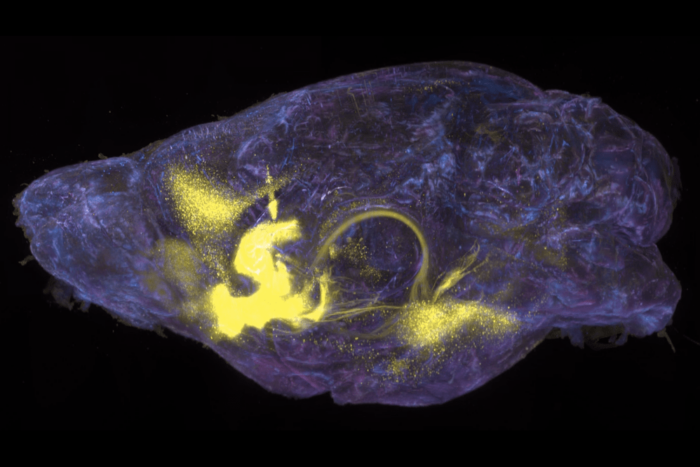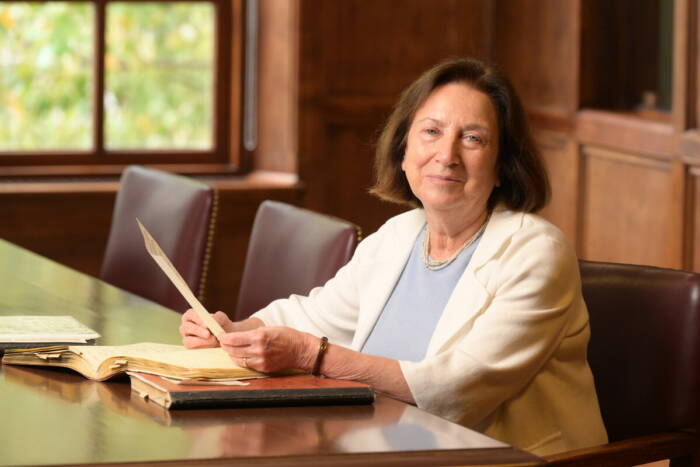Norton Zinder, pioneering molecular geneticist, dies at 83
Norton D. Zinder, a geneticist and microbiologist whose research on the genetics of bacteria and on the properties of bacteriophages — viruses that infect bacteria — provided seminal information on the mechanisms of heredity, died February 3 after a long illness. He was 83.
Dr. Zinder was a John D. Rockefeller Jr. Professor Emeritus and spent his entire research career at Rockefeller.
“Norton was a founder of modern genetics,” says Michael Young, vice president for academic affairs and a close colleague of Dr. Zinder’s. “As Josh Lederberg’s first graduate student, he had a hand in many of the most basic developments connected to the birth of bacterial and bacteriophage genetics.”
Dr. Zinder’s first major discovery, transduction in bacteria, resulted from experiments performed in Dr. Lederberg’s lab, then at the University of Wisconsin. In 1949, the two began a series of investigations, based on the 1946 findings of Dr. Lederberg and Edward Tatum that two strains of the bacterium Escherichia coli could mate under certain conditions. Dr. Zinder and Dr. Lederberg attempted to induce mating in another species of bacterium,Salmonella typhimurium. The expected colonies of the new type of cells appeared, but further analysis revealed that they were the product not of sexual mating, but of a hitherto unknown process, now designated “transduction,” whereby bacteriophages act as carriers of genetic material from donor to recipient bacteria.
These experiments and the resulting methodology made transduction a powerful tool for the study of bacterial genetics and for such applied problems as antibiotic resistance and bacterial classification. Further research enabled Dr. Zinder and his colleagues to develop techniques for mating Salmonella which allow for the specific differentiation of donor (male) and recipient (female) bacteria.
“Norton’s monumental discovery of transduction, and his proof that it involved a virus carrying foreign, bacterial genes between cells, provided a first look at nature’s own recombinant DNA,” says Dr. Young. “His later work on restriction enzymes, rules for protein synthesis, and his early, persuasive leadership in the human genome project, were also central to the growth of molecular biology.”
Upon moving to Rockefeller, Dr. Zinder further pursued his studies of transduction and confirmed that transduction is mediated by viral particles exchanging their own DNA for bacterial DNA, which they then carried. This discovery anticipated the use of recombinant DNA in the 1970s.
In 1960, Dr. Zinder and Timothy Loeb, then a graduate student in his laboratory, discovered seven new bacterial viruses specific for E. coli males, one of which proved to be the first known RNA-containing bacteriophages. This discovery of the RNA phages had great importance in studies of fundamental genetic processes because their unusually small size — smaller than the polio virus and with half its genetic material — made it possible to identify each submolecule of their genetic code.
Additional investigations of the RNA bacteriophages led Dr. Zinder and his laboratory group to the first demonstration, in 1962, that virus replication in the RNA phage is not dependent on DNA. It also provided further details of protein biosynthesis, including the finding that ribonucleic acid carries the blueprint for the manufacture of protein.
Dr. Zinder’s research on molecular and physiological genetics emphasized genetic recombination and the physical mapping of phage genomes by means of restriction enzymes that cleave genetic material. The tools he developed for this work continue to be used widely.
“Norton made many contributions because he kept experimenting, his mind could not stop,” says Jesse Ausubel, director of the Program for the Human Environment and a longtime friend of Dr. Zinder’s. “Everything had an almost frightening immediacy to him, the countless lectures and thesis presentations he loyally attended at Rockefeller, articles in The New York Times, a casual remark in a committee meeting, an experiment in his lab, a missed opportunity by the Mets or Knicks, a family trip to Italy or Israel. It was as if everything that had ever happened to him in his life had happened that day.”
Dr. Zinder was born in New York City on November 7, 1928. He graduated from Bronx High School of Science at the age of 15 and received an A.B. degree from Columbia University three years later. In 1952, he received his Ph.D. from the University of Wisconsin and joined The Rockefeller University — then known as The Rockefeller Institute for Medical Research — as an assistant. He was appointed associate in 1956, associate professor in 1958, professor in 1964 and John D. Rockefeller Jr. Professor in 1977. From 1993 to 1995, he served as the university’s dean of graduate and postgraduate studies.
In addition to his research on molecular genetics, Dr. Zinder was an active spokesman on the responsibilities of scientists. In 1973 he chaired a committee that evaluated the National Cancer Institute’s nine-year-old Virus Cancer Program. The committee’s findings, known as the Zinder Report, resulted in a major reorganization of the program. One of the original members of the Committee on Recombinant DNA Molecules of the National Research Council of the National Academy of Sciences, he was among the 140 molecular biologists who gathered in Asilomar, California to develop a set of guidelines for the safe use recombinant DNA technology. In the early 1980s he chaired a committee of the National Academy of Sciences and the Nuclear Regulatory Commission which made recommendations on the technical means for disposal of the large U.S. stockpile of chemical weapons.
“Among his other contributions, Norton was an enthusiastic supporter of the human genome project, and without him it might have taken much longer to complete,” says Professor Emeritus Peter Model, who joined Dr. Zinder’s Laboratory of Genetics as a postdoctoral fellow in 1967 and became co-head of the lab in 1987. “Many scientists were wary of it for reasons ranging from fear that it would consume too much in the way of resources, both financial and human, and because it seemed to them mindless. So far the project and the infrastructure built around it have led to exciting science that promises to revolutionize both medicine and biology.”
Elected a member of the National Academy of Sciences in 1969, Dr. Zinder was a member of the American Academy of Arts and Sciences, the American Society of Biological Chemists, the Genetics Society of America, the American Society of Microbiology, the American Association for the Advancement of Science and Sigma Xi. He received the Eli Lilly Award in Microbiology in 1962, the United States Steel Foundation Award from the National Academy of Sciences in 1966, Columbia University’s Medal of Excellence 1969 and the Scientific Freedom and Responsibility award from the American Association for the Advancement of Science in 1982.
He was married to the former Marilyn Estricher, who died in 2004. He is survived by his sons, Stephen and Michael, and five grandsons.
“I’ve come to understand and appreciate the enormous influence Norton has had on how I do my science,” says Jeffrey V. Ravetch, Theresa and Eugene M. Lang Professor and a former graduate student of Dr. Zinder’s. “Norton’s standards weren’t just high, they were nearly unattainable. The lesson was clear — it wasn’t good enough to be the best in your field, you had to create new fields and in so doing change the way everyone else understood the world.”


